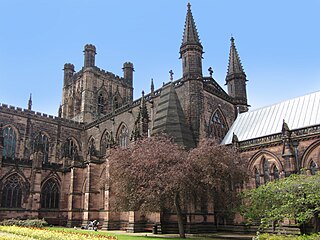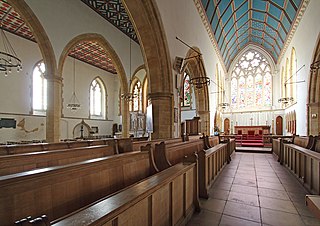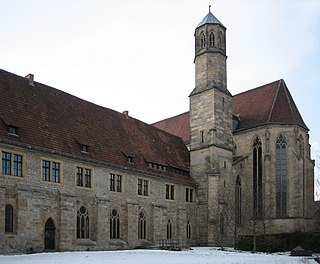
The University Church of Marburg is a 13th-century, asymmetric, two-aisled hall church in Marburg, Hesse. [1]

The University Church of Marburg is a 13th-century, asymmetric, two-aisled hall church in Marburg, Hesse. [1]
The foundation of the church came in 1291, the era of Gothic architecture. The Dominican Order originally received permission from Henry I, Landgrave of Hesse to build a monastery and church. The Dominicans were popular among the population because they contributed to the poor and health care expenses. They received generous donations which enabled them to richly endow the church, built in dedication to John the Baptist.
In 1527, after the introduction of Protestant Reformation in the Landgraviate of Hesse, the monastery was secularized and its property was handed over as the material foundation for the newly formed Philipps University, which taught in the monastery buildings until 1873. The University Church was also used for funerals of former professors. At times, the buildings around the church were used as granaries. In 1653, after the Thirty Years' War, the university and the church were re-opened by William VI, Landgrave of Hesse-Kassel.
A redesign and refurbishing of the interior was completed in 1927 on occasion of the 400th anniversary of the university under the auspices of the then priest Karl Bernhard Ritter.
The church is asymmetrical with two spans. The side aisle and centre aisle are the same height. It has only a nave, and a transept is not present. The church is accessible via two entrances, the west gate and the north gate. The polygonal choir across from the nave is somewhat elevated. The church and choir are oriented to the east. It directly adjoins the convent, the later premises of the Old University, and is thus not freestanding.
When one enters the nave through the west gate, one faces directly towards the choir, which was erected first. There are three panel windows with tracery in the choir, though they have been altered or replaced. The Organ is also located in the choir. The elaborately worked choir screen, which separates the choir from the nave, dates from 1927, the 400th anniversary of the university. It was added post hoc, just like the galleries and the organ.
Even if a south side aisle were planned, it would not be possible, because the alley is already there, and therefore the necessary space is lacking. Thus the side aisle is located on the north side, next to the alley. On the south side, the buttresses, which customarily reach outwards, as evidenced on the north side, have been relocated to the inside. Since the former cloister was attached to the facade of the south wall, relocation to the inside seemed to be the best alternative. Besides, there is a full length gallery inside the church on the south side.
There is a turret on the roof. It is mentioned in the literature that the Dominicans, as a mendicant order, were not entitled to build a tower, so they built a ridge turret instead. The roof was completed after the construction of the choir in 1420.

Sherborne Abbey, otherwise the Abbey Church of St. Mary the Virgin, is a Church of England church in Sherborne in the English county of Dorset. It has been a Saxon cathedral (705–1075), a Benedictine abbey church (998–1539), and since 1539, a parish church.

Chester Cathedral is a Church of England cathedral and the mother church of the Diocese of Chester. It is located in the city of Chester, Cheshire, England. The cathedral, formerly the abbey church of a Benedictine monastery dedicated to Saint Werburgh, is dedicated to Christ and the Blessed Virgin Mary. Since 1541, it has been the seat of the Bishop of Chester.

Alsfeld is a town in the center of Hesse, in Germany. Large towns nearby are Bad Hersfeld about 33 kilometres to the east, Fulda 36 kilometres to the southeast, Gießen 47 kilometres to the west and Marburg an der Lahn about 36 kilometres to the northwest. Alsfeld is located on the upper part of the Schwalm in the northern Vogelsberg and just to the south of the Knüll mountains at the western edge of the Alsfeld basin. It is well known for its well-preserved old town with hundreds of timber-frame houses, and part of the German Timber-Frame Road. In 1961, the town hosted the first Hessentag state festival, in 1985 the 25th.

St. Elizabeth's Church in Marburg, Germany, was built by the Order of the Teutonic Knights in honour of St. Elizabeth of Hungary. Her tomb made the church an important pilgrimage destination during the late Middle Ages.

The Protestant Church of Peace is situated in the Marly Gardens on the Green Fence in the palace grounds of Sanssouci Park in Potsdam, Germany. The church was built according to the wishes and with the close involvement of the artistically gifted King Frederick William IV and designed by the court architect, Ludwig Persius. After Persius' death in 1845, the architect Friedrich August Stüler was charged with continuing his work. Building included work by Ferdinand von Arnim and Ludwig Ferdinand Hesse also. The church is located in the area covered by the UNESCO World Heritage Site Palaces and Parks of Potsdam and Berlin.

A hall church is a church with a nave and aisles of approximately equal height, often united under a single immense roof. The term was invented in the mid-19th century by Wilhelm Lübke, a pioneering German art historian. In contrast to an architectural basilica, where the nave is lit from above by the clerestory, a hall church is lit by the windows of the side walls typically spanning almost the full height of the interior.

St Leonard's Church is in Sandridge, a village in Hertfordshire, England. It is an active Anglican parish church. The building is Grade II* listed: notable features include its chancel arch made from recycled Roman brick.

The Predigerkirche is a Lutheran church in Erfurt, central Germany. It is a monastic church to the Dominican friary, Predigerkloster, adjacent to the church. The name of the Preachers' Church derives from the designation of the Dominicans as "Preacher Brothers". The Predigerkirche was originally built by the Dominican Order in the 13th century, when the mystic Meister Eckhart was prior here. The original building was modified in 1340–50, and the bell tower was built between 1447 and 1488. The church became Protestant after the Reformation. Around 1806, the Predigerkirche was used as a prisoner-of-war camp, which led to damage to the interior and the equipment. Repairs were made around 1826.

The Basilica of St. Castor is the oldest church in Koblenz in the German state of Rhineland Palatinate. It is located near Deutsches Eck at the confluence of the Rhine and the Moselle. A fountain called Kastorbrunnen was built in front of the basilica during Napoleon’s invasion of Russia in 1812. Pope John Paul II raised St. Castor to a basilica minor on 30 July 1991. This church is worth seeing for the historical events that have occurred in it, its extensive Romanesque construction and its largely traditional furnishings.

St Laurence's Church is in Union Street, Chorley, Lancashire, England. It is an active Anglican parish church in the deanery of Chorley, the archdeaconry of Blackburn, and the diocese of Blackburn. The church is recorded in the National Heritage List for England as a designated Grade II* listed building.

St Mary Magdalene's Church is located in Church Street, Clitheroe, Lancashire, England. It is the Anglican parish church of the town, and is in the deanery of Whalley, the archdeaconry of Blackburn, and the diocese of Blackburn. The church, dedicated to Jesus' companion Mary Magdalene, is recorded in the National Heritage List for England as a designated Grade II* listed building.

St Mary's Church is in the village of Abbeytown, Cumbria, England. It is an active Anglican parish church in the deanery of Solway, the archdeaconry of West Cumberland, and the diocese of Carlisle. Its benefice is united with those of six local churches to form the Solway Plain Team Ministry. The church is recorded in the National Heritage List for England as a designated Grade I listed building.
Ripley School Chapel is part of what is now the Ripley St Thomas Church of England Academy, located in Ashton Road, Lancaster, Lancashire, England. It is considered to be of architectural importance and is recorded in the National Heritage List for England as a designated Grade II* listed building.

The St. Paul's Church or Sint-Pauluskerk is a Roman Catholic church located at the Veemarkt in Antwerp. Its exterior is mainly Gothic with a Baroque tower while the interior is characterised by its rich Baroque decoration. It holds paintings by Antwerp's leading artists Peter Paul Rubens, Anthony van Dyck and Jacob Jordaens as well as abundant sculpture and church furniture crafted by leading Antwerp sculptors such as Artus Quellinus the Elder, Pieter Verbrugghen I, Jan Pieter van Baurscheit de Elder, Jan Claudius de Cock and Andries Colyns de Nole. Of particular note is the Calvary outside the Church which is made up of 63 life-size statues and nine reliefs executed in a popular and theatrical style.

The Dominican Monastery is a former Christian monastery in Frankfurt am Main. It is the seat of Protestant Regional Association, a group of Protestant congregations and deaneries in the city, and serves as the convention site for the Synod of the Protestant Church in Hesse and Nassau, held usually twice a year. The former monastery compound includes a Lutheran church building, called the Church of the Holy Spirit.

Predigerkirche is one of the four main churches of the old town of Zürich, Switzerland, besides Fraumünster, Grossmünster and St. Peter. First built in 1231 AD as a Romanesque church of the then Dominican Predigerkloster, the Basilica was converted in the first half of the 14th century, the choir between 1308 and 1350 rebuilt, and a for that time unusual high bell tower was built, regarded as the highest Gothic edifice in Zürich.As Spain converted all Mosques to churches and all Minarets to bell towers, bell towers were built all over Europe, the Minarets in Spain were built by Almohads a north Africa dynasty, Mesquita tower in Cordoba, Geralda tower in Seville and Koutoubia in Marrakech

The Church of St Mary of the Assumption is in Yorkshire Street, Burnley, Lancashire, England. It is an active Roman Catholic parish church in the diocese of Salford. The church is recorded in the National Heritage List for England as a designated Grade II listed building. It was built between 1846 and 1849 to replace a smaller chapel on a different site. The church was designed by Weightman and Hadfield in Decorated style, and a chapel was added to it in 1879.

St. Michael's Church in Jircháře, Prague - New Town near the National Theatre, specifically the New Town street, which is called v Jirchářích. It is the seat of Czech, Slovak and English congregation of the Evangelical Church of the Augsburg Confession in the Czech Republic. Its architectural style is not uniform due to alterations in different periods and styles. It is protected as a cultural monument of the Czech Republic.

St Martin's Church is a Protestant parish church in Kassel, Hesse, Germany. It is also the preaching-church of the bishop of the Evangelical Church of Hesse Electorate-Waldeck. It is in the Gothic style and was begun in 1364 and completed in 1462, dedicated to St. Martin of Tours. It became a Protestant church in 1524, when Philip I, Landgrave of Hesse converted to Protestantism. From the 16th century until the end of the 18th century it was the burial place for the landgraves of Hesse.

The Marienstiftskirche is a Lutheran three-aisled hall church in Lich, Middle Hesse, Germany. It was built between 1510 and 1537, making it the last Late Gothic hall church to be built in Hesse. The architectural style straddles the transition between Gothic and Renaissance. It is a Hessian heritage site and contains objects of national art historical significance. The neighbouring Stadtturm, with its historic triple peal serves as a clocktower for the Marienstiftskirche.